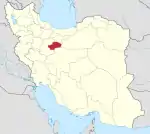Qomrud
Persian: قمرود | |
|---|---|
Village | |
 Qomrud | |
| Coordinates: 34°43′32″N 51°04′19″E / 34.72556°N 51.07194°E[1] | |
| Country | |
| Province | Qom |
| County | Qom |
| District | Central |
| Rural District | Qomrud |
| Population (2016)[2] | |
| • Total | 1,703 |
| Time zone | UTC+3:30 (IRST) |
Qomrud (Persian: قمرود; also Romanized as Qomrūd and Qumrūd)[3] is a village in, and the capital of, Qomrud Rural District of the Central District of Qom County, Qom province, Iran.[4]
At the 2006 National Census, its population was 1,922 in 443 households.[5] The following census in 2011 counted 1,882 people in 481 households.[6] The latest census in 2016 showed a population of 1,703 people in 493 households; it was the largest village in its rural district.[2]
Seventy percent of the village population speaks Turkic languages, 5–10% speak Afghan languages, and 20%–25% speak Persian languages.
History and culture
In general, the Qomrood area is one of the world's most populated places and places of transport for human beings in the BCE. It contains various historical monuments in different historical periods (scattered in the region), which include works such as Qarat-e-Tappeh Qamroud is evidence of this
Large areas of Iran have ancient civilizations. Qamrood area is one of those areas that retained elements from the days of the early period of civilization's presence. The first ancient prayers on the Iranian plateau were made in this area. Some historians have attributed the original construction of this area to Alexander, Bohram Gore, Tahmurth, Lhrassap, Ghobad Sassanid, Yazdgerd III, and several others, and there are disagreements over this. Archaeologists such as Roman Cirsman consider Qom to be the oldest region in which human beings have settled there and have established the first civilizations. New archaeological results also date the Qomrud region more than 7,000 years ago. Archaeologists claim that due to the existence of the Qamrood River and the presence of the Shah, the roadway of the Silk Road has been the source of civilizations since the early days of history. In the region, about 130 ancient works, mostly belonging to the Sassanid and Parthian era, have been identified.
Economy
The job of the people of Qomroud rural district is often agricultural and part of the population is also engaged in animal husbandry. This rural district is one of the most important agricultural and livestock fields of Qom province. In the past, a large part of agricultural agriculture in this village was provided by qanat and Qomrood river, but Time lapse and rainfall reduction, and by the construction of the dam of 15 Khordad in the south of the river, farmers have been stopped by the river and today they are supplied with agricultural aquifers.
The products of this village are often barley and alfalfa, but in recent decades pistachio planting has grown strongly in this village, and most farmers have turned to gardening with drought-resistant trees and over the past few years wheat has been cultivated Almost entirely out of the agricultural industry of this village.
In recent years, women in this village have turned to home-based businesses, and home-based businesses have become widespread in the Qomroud region.
References
- ↑ OpenStreetMap contributors (13 May 2023). "Qomrud, Qom County" (Map). OpenStreetMap. Retrieved 13 May 2023.
- 1 2 "Census of the Islamic Republic of Iran, 1395 (2016)". AMAR (in Persian). The Statistical Center of Iran. p. 25. Archived from the original (Excel) on 11 January 2021. Retrieved 19 December 2022.
- ↑ Qomrud can be found at GEOnet Names Server, at this link, by opening the Advanced Search box, entering "-3080368" in the "Unique Feature Id" form, and clicking on "Search Database".
- ↑ Mousavi, Mirhossein (2 February 1366). "Creation and formation of nine rural districts including villages, farms and places in Qom County under Tehran province". Lamtakam (in Persian). Ministry of Interior, Council of Ministers. Archived from the original on 9 January 2024. Retrieved 9 January 2024.
- ↑ "Census of the Islamic Republic of Iran, 1385 (2006)". AMAR (in Persian). The Statistical Center of Iran. p. 25. Archived from the original (Excel) on 20 September 2011. Retrieved 25 September 2022.
- ↑ "Census of the Islamic Republic of Iran, 1390 (2011)". Syracuse University (in Persian). The Statistical Center of Iran. p. 25. Archived from the original (Excel) on 20 January 2023. Retrieved 19 December 2022.
